Table of Contents
”UPSC News Diary For Today” is every day published in the evening between 6-7 PM and contains all current affairs articles from the day on a single platform. ”UPSC News Diary For Today” covers various topics from UPSC Syllabus and is very helpful and time managing for UPSC Aspirants. The framing of this daily current affairs compilation article is easy to read and understandable also.
In the ”UPSC News Diary For Today” article, we focus on both UPSC Preliminary and Mains exam-oriented current affairs & prepare a gist of daily important news articles from leading National Newspapers, PIB, and other various official sources.
Who is Salman Rushdie?
Why in News?
Author Salman Rushdie, who suffered years of Islamist death threats after writing The Satanic Verses, has been stabbed on stage in New York
About Salman Rushdie
- Indian-born novelist Mr Rushdie catapulted to fame with Midnight’s Children in 1981, which went on to sell over one million copies in the UK alone.
- But his fourth book, in 1988 – The Satanic Verses – forced him into hiding for nine years.
- The surrealist, post-modern novel sparked outrage among some Muslims, who considered its content to be blasphemous, and was banned in some countries.
- A year after the book’s release, Iran’s Supreme Leader Ayatollah Khomeini called for Mr Rushdie’s execution.
Elephant Reserves in India
Why In News?
August 12 was world elephant day.
Elephant Reserves in India
- India has the largest and the most stable population of Asian elephants. In fact, more than 60% of wild Asian elephants are in India.
- The population of 29,964 elephants as recorded in the last elephant census conducted in 2017 speaks volumes of the passion for wildlife conservation ingrained in Indian culture.
- India has 31 Elephant Reserves. In the last 3 years, Dandeli Elephant Reserve has been notified by the state of Karnataka, Singphan Elephant Reserve by Nagaland and Lemru Elephant Reserve in Chhattisgarh. This has brought the total area under Elephant Reserves in India to about 76,508 sqkm across 14 states of the country.
- India is going to witness the establishment of one more Elephant Reserve, the Agasthiyamalai in Tamil Nadu, adding yet another 1197 sqkm of Protected Area dedicated for protection and conservation of elephants in India.
National e-Governance Division (NeGD)
- In 2009, National e-Governance Division was created by the Ministry of Electronics & Information Technology as an Independent Business Division under the Digital India Corporation {erstwhile Media Lab Asia}.
- Since 2009, NeGD has been playing a pivotal role in supporting the Ministry of Electronics & Information Technology in Programme Management and implementation of e-Governance Projects and initiatives undertaken by Ministries/ Departments, both at the Central and State levels.
- The envisioned roles and responsibilities of NeGD are as follows:
-
- Providing strategic direction in terms of framing policies and implementation strategy for the Digital India Programme in different domains of e-Governance
- Proactive support to Central and State Governments for Mission Mode Projects and other e-Governance projects
- Acting as a facilitator and catalyst for implementation of Digital India Program by various Ministries and State Governments
- Providing technical assistance to Central Ministries/ State Line Departments in their e-Governance projects either directly or in collaboration with professional consultants, etc.
Chronic Fatigue Syndrome
Why in News?
A woman from Bengaluru has filed a petition in the Delhi High Court to stop her Noida-based friend, who has been suffering from Chronic Fatigue Syndrome since 2014, from travelling to Europe to undergo a physician-assisted euthanasia.
What is Chronic Fatigue Syndrome?
- Chronic Fatigue Syndrome also known as myalgic encephalomyelitis (ME/CFS) is a serious and debilitating disease that affects the nervous system, the immune system and the body’s production of energy, according to the US Centres for Disease Control and Prevention (CDC).
- Its causes are still unknown. However, the potential triggers would include viral or bacterial infection, hormonal imbalances and genetic predispositions.
- There is no specific test for the disease, and doctors have to rely on medical examinations, blood and urine tests.
- ME/CFS can affect anyone, from children to adults of all ages. According to the CDC, it’s more common in women and people between 40 and 60 years old.
- The biggest telltale symptom is a significantly lowered ability to do activities that were performed before the illness. This is accompanied by at least 6 months (or longer) of debilitating fatigue that is more severe than everyday feelings of tiredness. This fatigue is not relieved by sleep or rest and exercising usually makes the symptoms worse, according to the UK’s National Health Services (NHS).
”Miyawaki Forest”
”Miyawaki Forest”: Introduction
- So far, nearly 200 Miyawaki forests have been set up across the country in the past decade.
- Miyawaki forests are springing up across Indian cities.
- Whether they are a way to restore urban biodiversity or just a quick-fix to achieve greenery is the biggest question so far.
”Miyawaki Forest”: What is Miyawaki Forest?
- Miyawaki is the dense urban forest which ia created following a method propounded by Japanese botanist Akira Miyawaki in the 1980s.
- The method essentially compresses layers of a forest—biomass, tree numbers and canopy spread—to fit on a small patch of land and also reduces the time taken for it to grow.
- For instance, under the method, saplings are planted with a gap of 30 cm against the conventional practice where the gap between two saplings is 2.4 m. Such dense plantation induces competition among the trees for sunlight, which then grow taller to avoid being shaded by others.
- As per an estimation by Miyawaki, who has created 1,500 such forests across Japan, India, South East Asia and Brazil, trees in a dense plantation grow 10 times faster than most other plants and result in 30 times denser vegetation in just two to three years.
”Miyawaki Forest”: Key Benefits
- In theory, the method offers a holistic solution to several urban woes, including the heat island effect, air and noise pollution and land crunch for greenery.
- This afforestation method is fast gaining attention across the country, from civic bodies and forest department officials to private groups and non-profits.
- The biggest achievement of the Miyawaki method is that it could bring back the forest that would have existed before human interventions. It would also reduce the heat island effect by several degrees.
- In cities like Bengaluru, Chennai and Hyderabad that are cramped with concrete jungle, Miyawaki forests are a great way of not only achieving quick greenery but also mitigating carbon emissions, purifying air with more oxygen and restoring soil and biodiversity.
- Miyawaki technique is an effective solution for rural places like Punjab, which has less forest cover.
”Miyawaki Forest”: Are they equivalent to natural forests?
- Miyawaki plantation does not fit the definition of natural forest, especially in India, which has hundreds of forest types spread across geographies.
- The forest formation process is slow as trees grow at their pace, enabling the soil conditions to change, microbes, earthworms and insects to flourish and host a wide range of biodiversity.
- A natural forest also allows a food chain to be established. Such is not the case with Miyawaki technique.
- So, it will take time to understand long-term effects of Miyawaki forests on ecology.
”Miyawaki Forest”: Can It Restore Soil?
- Miyawaki is the best solution to bring back nutrients and life to the soil, damaged by excessive use of pesticides and insecticides during farming.
- The technique helps regenerate and reforest farmland that has lost its productivity from decades of chemical-intensive practices.
- In case of a drought or intense condition, Miyawaki forests in arid areas can become more susceptible to catching fire. In such a scenario, all the carbon captured by the plants will go up in smoke along with the immense amount of water and money invested in the forest.
- A degrading land can start taking shape by hosting biodiversity in three to five years and sequester more carbon, which is the objective of tree plantation.
75 Ramsar Sites in 75th year of Independence
Why In News?
- India adds 11 more wetlands to the list of Ramsar sites to make total 75 Ramsar sites covering an area of 13,26,677 ha in the country in the 75th year of Independence.
- The 11 new sites include: Four (4) sites in Tamil Nadu, Three (3) in Odisha, Two (2) in Jammu & Kashmir and One (1) each in Madhya Pradesh and Maharashtra. Designation of these sites would help in conservation and management of wetlands and wise use of their resources.
India and Ramsar Convention
- India is one of the Contracting Parties to Ramsar Convention, signed in Ramsar, Iran, in 1971.
- India signed it on 1st Feb 1982.
- During 1982 to 2013, a total of 26 sites were added to the list of Ramsar sites, however, during 2014 to 2022, the country has added 49 new wetlands to the list of Ramsar sites.
- During this year itself (2022) a total of 28 sites have been declared as Ramsar sites.
- Based on the date of designation mentioned on Ramsar Certificate, the number is 19 for this year (2022) and 14 for previous year (2021).
- Tamil Nadu has maximum no. of Ramsar sites (14 nos), followed by UP which has 10 nos. of Ramsar sites.
Know About 11 New Ramsar Sites
1. Tampara Lake
- Tampara Lake is among the most prominent freshwater lakes in the State of Odisha situated in Ganjam district. The depression on the ground gradually filled with rainwater from catchment flow and was called “Tamp” by the British and subsequently termed “Tampra” by the locals.
- The wetland supports at least 60 species of birds, 46 species of fishes, at least 48 species of phytoplanktons, and more than seven species of terrestrial plants and macrophytes.
- The wetland is an important habitat for vulnerable species such as Cyprinus carpio, common pochard (Aythya ferina), and river tern (Sterna aurantia).
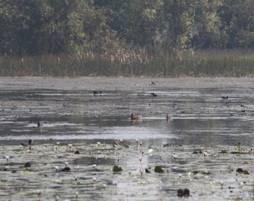
2. Hirakud Reservoir
- Hirakud Reservoir, the largest earthen dam in Odisha started operating in 1957.
- Out of the known 54 species of fish from the reservoir, one has been classed as being endangered, six near threatened and 21 fish species of economic importance.
- Similarly, over 130 bird species have been recorded at this site, out of which 20 species are of high conservation significance.
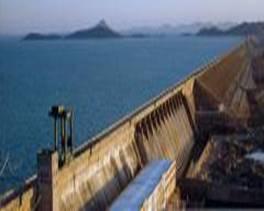
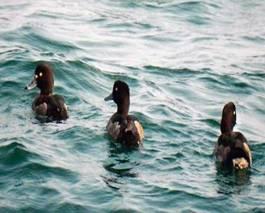
Hirakud Reservoir Migratory Birds
3. Ansupa Lake
- Ansupa Lake is the largest freshwater lake of Odisha situated in Banki sub-division of Cuttack district and has its fame from time immemorial for its scenic beauty, biodiversity, and natural resources.
- The wetland is an oxbow lake formed by River Mahanadi and is spread over an area of 231 ha.
- The wetland is home to at least 194 species of birds, 61 species of fishes and 26 species of mammals in addition to 244 species of macrophytes.
- The wetland provides a safe habitat to at least three threatened bird species- Rynchops albicollis (EN), Sterna acuticauda (EN) and Sterna aurantia (VU) and three threatened fish species- Clarias magur (Clariidae) (EN), Cyprinus carpio (Cyprinidae) (VU) and Wallago attu (VU).
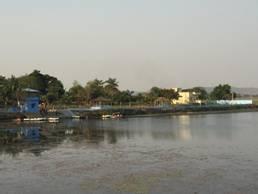
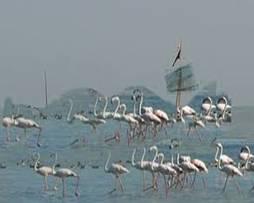
4. Yashwant Sagar
- Yashwant Sagar is one of the two Important Bird Areas (IBA) in the Indore region as well as one of the most important birding sites in Malwa region of Madhya Pradesh.
- Presently it is mainly used for water supply to the city of Indore and is also being used for fish culture on a commercial scale.
- Yashwant Sagar is considered to be a stronghold of the vulnerable Sarus Crane in central India.
- The lake backwaters have plenty of shallow areas, conducive for waders and other waterfowl.
- Due to its vast shallow reed beds, the wetland is considered heaven to a large number of winter migratory birds.
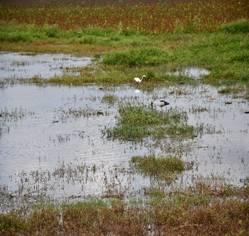
Heronry birds, Yashwant Sagar
5. Chitrangudi Bird Sanctuary
- Chitrangudi Bird Sanctuary, locally known as “Chitrangudi Kanmoli” is located in Ramanathapuram district in Tamil Nadu.
- The wetland is a protected area since 1989 and declared as Bird Sanctuary.
- Chitrangudi Bird Sanctuary is an ideal habitat for winter migratory birds. Around 50 birds belonging to 30 families have been reported from the site. Out of these 47 are water birds and 3 terrestrial birds.
- Notable waterbirds spotted from the site area spot-billed pelican, little egret, grey heron, large egret, open billed stork, purple, and pond herons.
- Chitrangudi is surrounded by agricultural fields, where different crops are grown throughout the year.
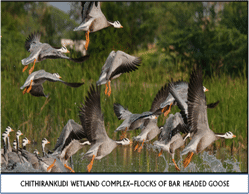
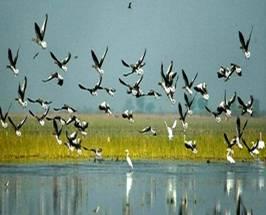
6. Suchindram Theroor Wetland Complex
- Suchindrum Theroor Wetland complex is part of the Suchindrum-Theroor Manakudi Conservation Reserve.
- It is declared an Important Bird Area and lies at the southern tip of the Central Asian flyway of migratory birds. It was formed for birds’ nesting purposes and it attracts thousands of birds every year.
- Copper plate inscriptions from the 9th century mention Pasumkulam, Venchikulam, Nedumarthukulam, Perumkulam, Elemchikulam and Konadunkulam.
- Around 250 species of birds have been recorded in the area, of which 53 are migratory, 12 endemic, and 4 threatened.
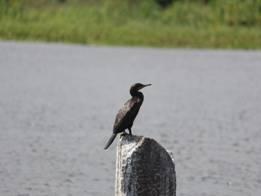
Indian Cormorant
7. Vaduvur Bird Sanctuary
- Vaduvur bird sanctuary spreads over an area of 112.638 ha, is a large human-made irrigation tank and shelter for migratory birds as it provides a suitable environment for food, shelter, and breeding ground.
- While these irrigation tanks have socio-economic and cultural significance, very little is known of their ecological importance.
- Large concentrations of wintering waterfowl such as Eurasian Wigeon Anas penelope, Northern Pintail Anas acuta, Garganey Anas querquedula were recorded in tanks.
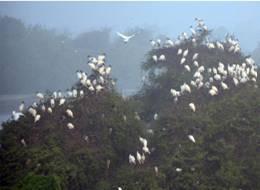
Black headed Ibis nest
8. Kanjirankulam Bird Sanctuary
- Kanjirankulam Bird Sanctuary is a Protected area near Mudukulathur Ramanathapuram District, Tamil Nadu. India, declared in 1989.
- It is notable as a nesting site for several migratory heron species that roost in the prominent growth of babul trees there.
- The breeding population of migratory waterbirds arrive here between October and February and include: painted stork, white ibis, black ibis, little egret, great egret.
- The site qualifies as an IBA as the threatened Spot-billed Pelican Pelecanus philippensis breeds here.
- The wetland exhibits rich biodiversity including many globally near-threatened species like Spot-billed Pelican, Oriental Darter, Oriental white Ibis and Painted Stork and also commonly occurring shore and water birds like greenshank, plovers, stilts and forest birds like bee-eaters, bulbuls, cuckoos, starlings, barbets, etc. They act as breeding, nesting, roosting, foraging, and stopover sites for the birds.
- The wetland supports IUCN RedList vulnerable avian species like Sterna aurantia (River Tern).
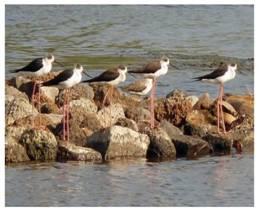
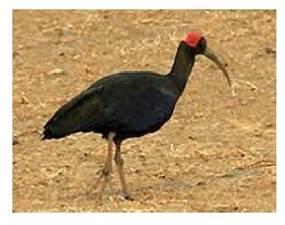
Black winged stilt Black Ibis
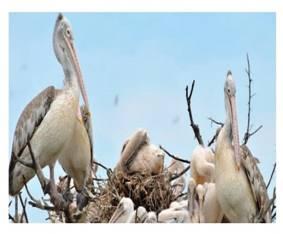
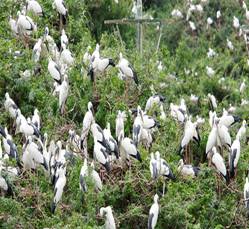
Spot-billed pelican nesting site Kanjirankulam Bird Sanctuary
9. Thane Creek
- Thane Creek is located in Maharashtra, India.
- There are several sources of fresh water to the creek, of which Ulhas River is the largest, followed by many drainage channels from various suburban areas of Mumbai, Navi Mumbai & Thane.
- It has been declared as Thane Creek Flamingo Sanctuary.
- Thane creek is fringed by mangroves on both banks & comprises around 20% of the total Indian mangrove species.
- The mangrove forest acts as a natural shelter belt & protects the land from cyclones, tidal surges, seawater seepage & intrusions. The mangrove serves as a nursery for several fishes & sustains the local fishery.
- The area is an important part of the wetland complex of the Central Asian Flyway of the birds and has been categorized as an Important Bird Area (IBA).
- Other than 202 avifaunal species, the creek also houses 18 species of fishes, crustaceans & molluscs, 59 species of butterflies, 67 species of Insects, and 35 species of phytoplankton, and 24 species of zooplankton & 23 species of Benthos.
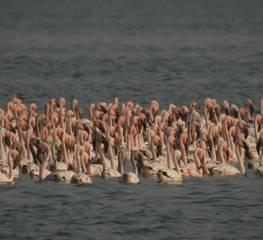
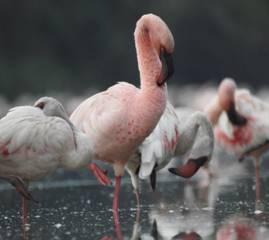
congregation of Lesser flamingos
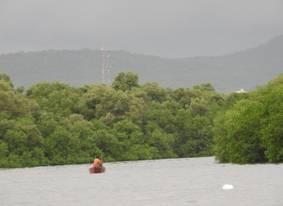
Mangroves of Thane creek
10. Hygam Wetland Conservation Reserve
- Hygam Wetland falls within the River Jhelum basin and plays a significant role as a flood absorption basin, biodiversity conservation site, eco-tourism site, and livelihood security for the local communities.
- The wetland is located in the Baramulla district. It serves as an abode to many residents and migratory bird species.
- It is also recognized as an Important Bird Area (IBA).
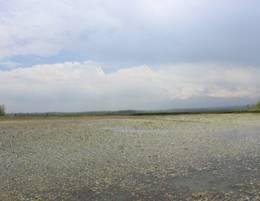
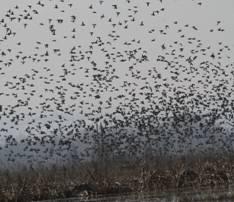
Photograph of the flood basin Migratory Waterfowl congregation at Hygam wetlan
11. Shallbugh Wetland Conservation Reserve
- Shallabug Wetland Conservation Reserve is located in the District Srinagar, UT of J&K.
- Large areas of the wetland dry up between September and March.
- The area has extensive reedbeds of Phragmites communis and Typha angustata, and rich growth of Nymphaea candida and N. stellata on open water.
- It serves as an abode to more than four lakh resident and migratory birds of at least 21 species.
- Shallabugh Wetland plays a major role in the natural control, amelioration or prevention of flooding.
- It is also important for seasonal water retention for wetlands or other areas of conservation importance downstream.
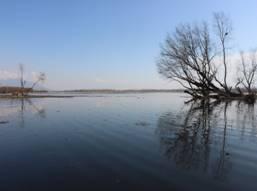
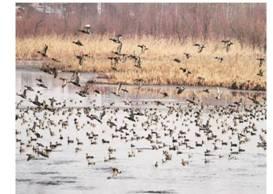



 TSPSC Group 1 Question Paper 2024, Downl...
TSPSC Group 1 Question Paper 2024, Downl...
 TSPSC Group 1 Answer key 2024 Out, Downl...
TSPSC Group 1 Answer key 2024 Out, Downl...
 UPSC Prelims 2024 Question Paper, Downlo...
UPSC Prelims 2024 Question Paper, Downlo...




